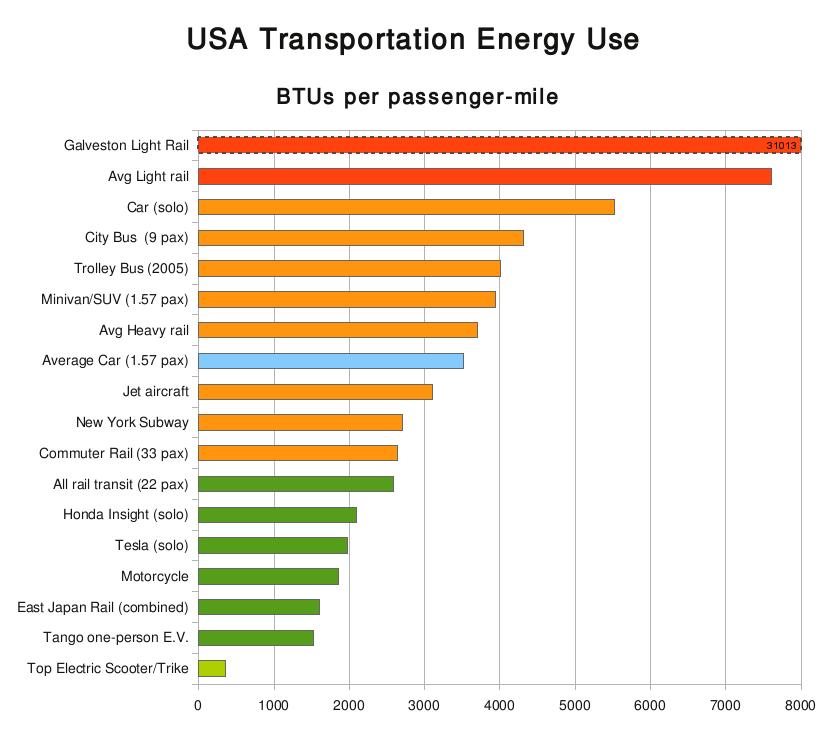The Big Energy Picture
I'm currently stuck at home with the flu--I'm feeling moderately wrecked (as opposed to completely wrecked, earlier this week), with a temperature of ~100 F. When I saw the doctor yesterday, he said, "If you still have a fever, you should be at home, instead of infecting your coworkers. I can write you a note." More importantly, there was an office potluck today--the last thing I ought to be doing is food prep for my coworkers--so I begged off.
So a reasonable way to spend a sick day would be curled up on the couch with a cup of tea, and catching up on Survivor or How It's Made episodes. Yeah, but you guys know me better. One thing that has been on my to-do list for a while: a colleague of mine (Martin Holladay) writes a column for the Green Building Advisor website called "Musings of an Energy Nerd"--it's really good, giving layperson explanations, but I also learn stuff when I read his columns. A recent one was titled Houses versus Cars:

He points out that you might want to figure out how much total energy you are using on transportation, vs., say, this home energy thing--and see which one matters more in your personal case. Some of his key conclusions were:
- Transportation energy use is significant. The average American family uses more energy to operate their cars than their home.
- Many of us are willing to spend hundreds of dollars on a new water heater, in hopes of saving only 10% on our water heating bill. But we could save twice as much energy by simply choosing a car that gets only 1 mpg better mileage than the average car.
- Anyone who succeeds in living without a car should be honored. Good work, bicycle commuters! Keep pedaling.
So I wanted to do this exercise myself, working out my energy consumption figures for 2009. Yeah, there's a reason I'm still single... oh wait, I'm not... crap, I need to get a new joke. Anyway, I keep extensive and dorky records, so I had a shot at putting together some reasonable numbers. Also, I know my driving patterns are far off from the averages, so I wanted to see how they all pencil in.
So here's the graph, showing Btus (units of energy) per quarter of 2009:

And here's how I came up with those numbers.
Gas and Electricity
I keep pretty close tabs on my gas bills and electricity bills--after all, this is part of what I do for a living. I converted all of this energy to "source" energy--in short, for each unit of energy at the electrical plug in your house, you need ~3x that much energy (coal, nuclear, gas) at the power plant to generate it. It's mostly the inefficiencies in generating electricity, as opposed to transmission line losses. Just think about it--those great big cooling towers that are dumping waste heat into the sky at power plants? Yeah, that's where most of that missing 2/3 is going.

You can see the obvious patterns--gas use (i.e., heating) is high in Q1 and Q4 (winters); electricity stays close to constant. Also, I compared how JMD and I are relative to the US average: we were at 80 million source Btus for 2009; the US average is 187 million (per household). Woot! That's about 40% of the US average. Go small apartments!
Automobile
I'm really happy about the fact that I have set up my life so I don't have to drive that much. 2008 was 4,786 miles; 2009 was a new record: 3,398 miles! For reference, a typical annual number is 12,000 miles per vehicle in the U.S.
So assuming 27 mpg (roughly my car's average mileage), and Martin's Btu/gallon numbers, my car use is a significantly smaller amount of energy than my home energy use. Cool.
Bus
Of course, although I seldom drive to work, I mix it up between biking and taking the bus. I started digging for numbers on passenger-mile fuel efficiencies of mass transit; one of the better ones I found was Is green U.S. mass transit a big myth?. It's written from the viewpoint of somebody who likes (and rides) mass transit, but is disappointed with where the numbers actually pencil in. For instance, you can see that is only marginally better than a car with a single driver, and worse than a car with a 1.57 passenger loading:

Note that his calculations assume a 9 passenger loading for a bus--although this is lower than what I typically see, remember that there is a serious observer effect going on:
A full bus or trainload of people is more efficient than private cars, sometimes quite a bit more so. But transit systems never consist of nothing but full vehicles. They run most of their day with light loads. The above calculations came from figures citing the average city bus holding 9 passengers, and the average train (light or heavy) holds 22. If that seems low, remember that every packed train at rush hour tends to mean a near empty train returning down the track. Remember, by definition most passenger experiences are on the fuller vehicles, which is why you probably think the average loads are higher than they are.
And San Jose Light Rail? Worse than a solo car? WTF? Is it constantly operating at a passenger loading of 1.1 or something? ("Okay, Bob's on the light rail again! Our numbers are up!")
However, take a look at the overall number--it is the barely-visible purple bars on the graph. This was based on my ballpark estimate of mileage--taking my T pass expenses from 2009, dividing by number of bus rides, and assuming 3 miles per ride (to and from work), that came out to ~300 miles per year. That's an order of magnitude lower than my driving (~3400 miles)--so the numbers make sense to me.
Airplane
Aha... yeah, this one is the real kicker. I have e-receipts for all of my flights, and it is easy enough to calculate mileages. Holy cats... in 2009, I flew a nominal 54,228 miles--that's 2.2x the circumference of the earth. No wonder I felt beat to hell this past year--Q3 and Q4 were particularly bad. Assuming 60 passenger miles per gallon of jet fuel and 130,000 Btu per gallon, those are the numbers that come out. I figured that this would be the case--my airline travel totally dominates over everything else I'm doing.
What's Missing
I fully acknowledge that this is not meant to be a complete picture of my energy use--it's missing some significant factors. For instance, I don't account for bicycle commuting energy use. There's been a large amount written there on fuel->food->bike->go, but I didn't want to bother to get into it. Also, I have to say that at least those calories are being burned off for a useful purpose, as opposed to waste heat in a gym.
I did not include the random other incidental transportation items--NYC to BOS bus, Amtrak, or subway rides.
Also, I have not talked about the energy costs associated with food production, which are huge. I don't know where those numbers stand on a per capita basis compared to mine, and I also don't have information on whether I would probably be + or - the average. My guess is that not eating much beef (maybe a few times a month?) is probably helpful, but I probably can't claim any great shakes (vegetarianism, no dairy, etc.).
Finally, I have not accounted for any of the embodied energy of The Crap That I Buy (i.e., see the Story of Stuff post). Not sure how much that accounts for, and I certainly didn't want to slog through doing the calculations.
Alternate Graph
Looking at this graph, there are a few things that would be fair to modify. First of all, JMD and I split the apartment, so in fairness, if I'm talking about my energy use, the gas & electricity numbers should be cut in half.
Also, the huge energy pit was air travel--but almost all (85%) of it was due to work. For argument's sake, only the trips I took for my own purposes (Alaska and Chicago) are plotted here.
Arguably, that means I should be able to chop my car number down as well--most of my car trips nowadays are, "Okay, we're going to the site in Fall River, or Chelsea today; guess I'm not biking/busing to work today." However, I left them as-is.

Other Cool Stuff
Finally, speaking of the Big Energy Picture, there's a graph that the Department of Energy's Energy Information Administration puts out every year--it's part of the 2008 Annual Energy Review. It shows the energy flows for the country, from all sources to all consumptions, divided up by type. I think it's a rather nice presentation of a large amount of data that would be really hard to compare as just columns of numbers.

You probably want to click on it to check it out in detail.


2 Comments:
The San Jose figure I find really surprising. The only explanation is this guy factoring the energy cost of liquifying natural gas, shipping it to Tijuana, and then gasifying and burning it, with really inefficient generators, to power some seriously Rube Goldberg power train in the trolleys.
Or something.
There's got to be a lot more to this. Is he comparing top of the line cars to seriously worn out city buses? Does he really think the 9x loading is typical? (It's gotta be better in Boston, since there is a lot of reverse commuting going on around here.)
Anyway, for biking, you really should just mark it as 0. Most people eat the same amounts when they commute by bike and when they don't. And since there is an energy cost to maintaining fatty tissue, it's usually a wash. Certainly in my case. My weight fluctuates 25 pounds, but my food consumption stays the same.
Does he really think the 9x loading is typical? (It's gotta be better in Boston, since there is a lot of reverse commuting going on around here.)
I believe he considers that the fleet average for city buses. It felt low, but then again, I have been on a #80 bus late at night, with 0 to 2 other people. And it seems completely likely that it is how it operates every night.
Post a Comment
<< Home